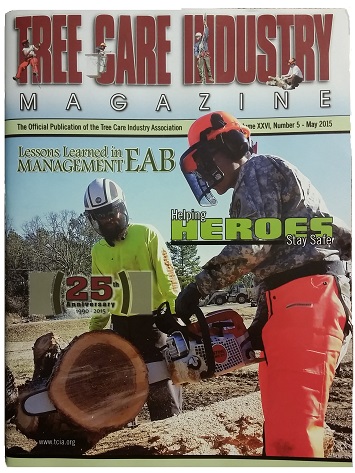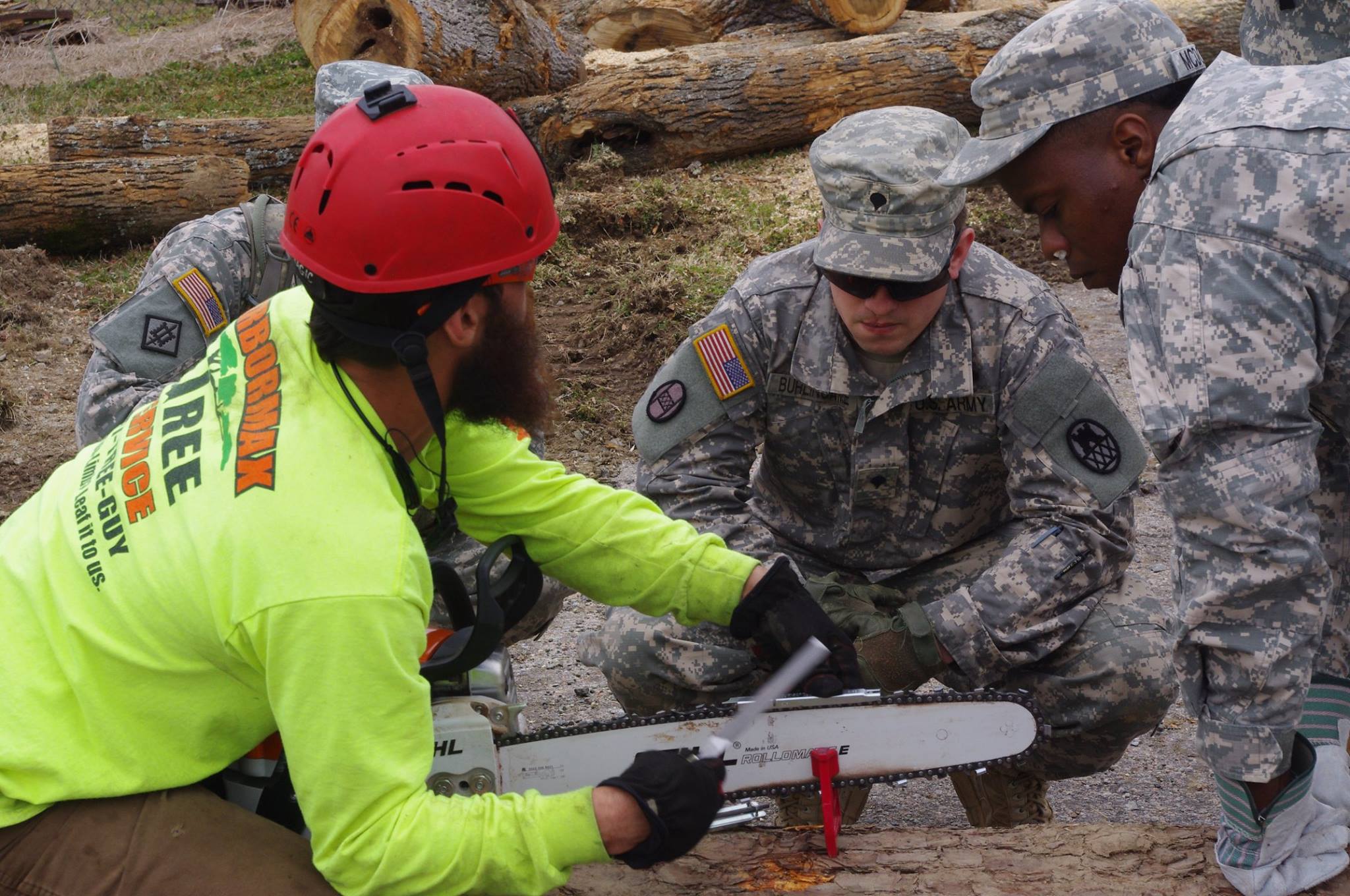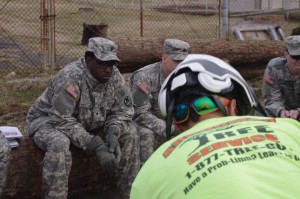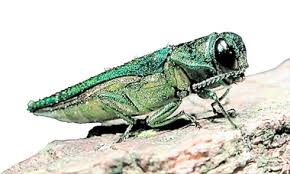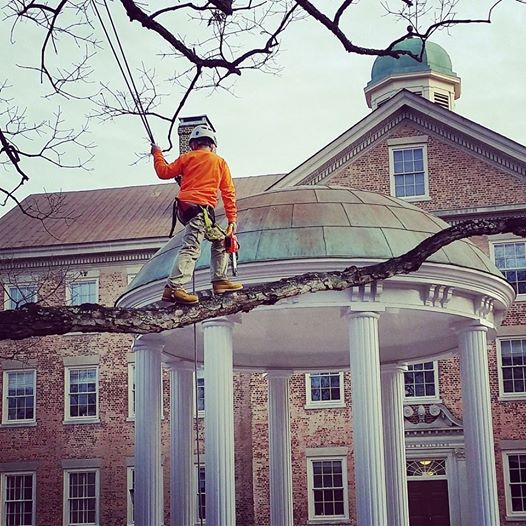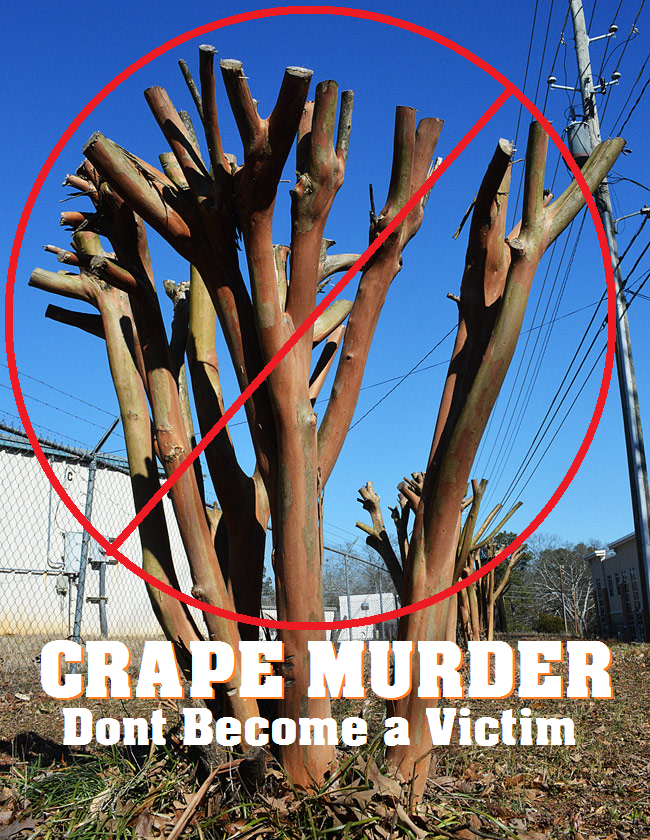We made the cover of our industries premier magazine. We recently conducted a week long training event for the amazing men and women of the 105th engineer Batallion with the North Carolina National Guard. We sent a write up to TCIA about the experience and they were so impressed that they made us the feature article. Thank you again to the Heroes of the Guard and thank you to TCIA as well.
Author: Arbormax
Mulch volcanos make us want to erupt!!!
If you didn’t think North Carolina had volcanos, think again. Just look around the next time you drive to the store. You will see mulch volcanos everywhere.
“Mulch volcano” is the term used to describe the improper mulching technique used frequently by homeowners and landscapers. A mulch volcano is a big mound of mulch that is piled too deep and incorrectly placed against the trunk of a tree. When mulch touches the bark or stem of a tree it creates a moist soggy environment. Over time it will lead decay, rot and disease. When mulch is piled too deep it can prevent water from getting down down to the soil. As a result some of the trees roots may grow up into the mulch in search of moisture. The tree may also die from drought like symptoms.
We recommended by keeping mulch 3-4 inches away from touching tree trunks. Mulch should only be 3-4” deep around trees. Always use organic mulch that is consistent with type of tree you are mulching. (hardwood for hardwood trees and pine for pine trees). This will help maintain the correct PH and nutrient balance.
Helping Heroes Stay Safe
Absolutely, positively, without a doubt this has been hands down the most awesome thing any of us at Arbormax Tree Service have ever been involved with. We had the honor and privilege of training the amazing men and women of the Army National Guard’s 105th Engineer Battalion on the fundamentals of chain saw safety, saw maintenance operations, and reactive forces. Over the course of five days in March, with nine classes, we trained approximately 150 soldiers. These courageous soldiers not only defend and protect our nation overseas, they also are ready and prepared to help us state side when things get tough and we need them most right here at home. The annual training of the battalion, arranged by the Army National Guard, lasts about two weeks and covers many scenarios that these troops may encounter during a state of emergency following a natural disaster.
Chances are, if you have been to an area effected by a major hurricane, ice storm, tornado, or other natural disaster, you have seen the Guard out in full force. They are always there without fail, whether passing out essential supplies to the community, maintaining peace and order, or, yes, with a chain saw in hand cutting their way into the devastation to help someone. All of us at Arbormax Tree Service, a TCIA member company based in Raleigh, North Carolina, are grateful for the service and commitment of these troops. We could think of no better way to show our gratitude than by training them to stay safe while operating one of the most deadly hand-held tools known to man, as well as making sure they truly understand how all of the saw’s components function to create a more efficient, and safer saw. This was a responsibility we did not take lightly. Between the three of us, Dick Pilcher, Joseph High II, CTSP, and myself Tim Robbins CTSP, we have more than 40 years of combined field experience. Two of us are Certified Treecare Safety Professionals and Certified Arborists, and the other is a certified tree climber. Combining years of experience and countless hours of homework and research, we developed a comprehensive program that allowed the soldiers to be directly engaged every step of the way
Starting with a solid foundation of the fundamentals and using hands-on training, the course we offered focused on realworld situations that these soldiers encounter after disasters. Some of these soldiers had never operated a chain saw, but they all walked away with the skills and a true understanding of the tool that would allow them a greater sense confidence to safely operate and care for the saw. Even those who had experience operating a saw before seemed to take a lot away from the program, telling us that we corrected some bad habits and work practices that had been in place.
We had to post these awesome pictures and a brief description. But to be honest, a million of these pictures and two million words couldn’t convey just how amazing this experience was. What else can we say. I guess in the words of these heroes. Hoooaaaaaaaaaaaaa!!!!
They’re heeeeeeeere
Emerald Ash Borer (EAB) have arrived in the Carolinas. This pest has devastated the Ash tree population in the northeast. It is perhaps the single most destructive insect to trees in history.
How do they kill trees? Adult beetles will lay their eggs on the bark of ash trees. After the eggs hatch, the larvae (immature beetles) bores into the bark of the tree and feeds on the vascular and transportation tissues of the tree. The damage from the boring process disrupts the movement of water and nutrients within the tree, effectively girdling it and leading to the tree’s death.
What can be done to stop them? Insecticides are available for prevention. Trees should be sprayed when the beetle is known to be in the area (20 miles). If a tree is already showing signs of infestation insecticides may be used to help trees recover. The recovery process is slow and may not take place at all.
The best defense is a good offense- If you have an Ash tree and want to save it please call us. We would love to come out and give you a free consultation.
Here are some helpful links to more info on EAB.
http://www.emeraldashborer.info/files/multistate_EAB_Insecticide_Fact_Sheet.pdf
Transplanting Trees for a great cause
In honor of our little friend Delaney receiving her heart transplant we are planting trees with heart shaped leaves (Eastern Redbud) to those who donate above a set minimum to her cause and are interested. Taylor’s Nursery in Raleigh has teamed up with the arborists here at Arbormax to help Delaney reach her much needed fundraising goal for medical expenses.
Miss Delaney is a precious 1 year old little angel that has been in Duke Children’s hospital since early November waiting on a heart transplant. Nothing Makes us happier than being able to say that she received her new heart February 5th and is doing amazing.
The uncovered medical costs associated with the lengthy stay and the transplant are overwhelming and exceed what a normal family could pay in ten years. The Children’s Organ Transplant Association also known as COTA is a non profit organization that helps families fundraise for these tremendous expenses. Delaney has a fundraising page set up through COTA and can be viewed at www.delaneysarmy.com
The Eastern Red bud tree is a magnificent specimen that has beautiful Magenta pink flowers that bloom spring to summer. The tree grows approximately 20-30 feet tall and has a canopy that spreads approximately 25 feet in width. The leaves are a heart shaped leaf.
Each tree will be delivered and installed at no cost. The tree will be approximately 6 feet tall and 2 inches in diameter at the base. All donations are to be made through COTA and are 100% tax deductible.
The typical cost for this tree and the planting service is $180.00. Any donation over $100 will be eligible to receive a tree. If you would like a tree installed please send us an email with your name and the donation amount.
We have 3 large Red Bud trees available that are approximately 15 ft tall and 4 inches in diameter. These usually retail around $450 installed. If you would like to make a donation above $250 you will receive one.
If you are in The Raleigh-Durham area and are interested in receiving a tree please call Tim 919-247-1985 or email us arbormaxx@aol.com to check availability. Please keep in mind that Delaney needs donations of all sizes. No amount is to small.
WE HEART DELANEY
www.delaneysarmy.com to make a donation
Another Certification well deserved for Arbormax Tree Service.
Rooted in the tree service industry
Fifty years ago my grandfather began teaching my father what he knew about trees. From the time I was a small boy my father has taught me the knowledge that was passed on to him as well as the skills that he had acquired through the years. I am happy to continue this tradition with my 3 sons. Just this summer my oldest son started his first summer internship with us officially making us 4 generations strong.
The picture you see here is of my youngest son and his toy chainsaw in a magnificent White Oak. At 11 years old this little guy has more sap running through his veins than any branch on our family tree. He eats sleeps and breaths tree climbing. It’s not just my sons that we like to brag about. Both of my daughters are amazing Jr. Arborists as well. In fact my 12 year old recently won a regional forestry competition.
Some people say you have to be crazy to do what we do. In our family we love what we do and we are crazy about it. Hopefully we can pass the tradition on for another 4 generations.
Crape Murder Don’t be a victim of bad tree pruning
There are very few shrubs and trees in North Carolina that can compete with the rich and vibrant colors of a Crape Myrtle in full bloom.
We often see Crape Myrtles that have been improperly pruned and topped. Crape Murder is what we jokingly call it. All jokes aside this type of tree pruning is bad for the tree and your wallet. Crape Myrtle trees are usually topped under the assumption that doing so will yield more flowers or create a better shape in the year to come. This is untrue and actually does the exact opposite. It is a common misconception that topping will yield more flowers. When in reality topping can actually cause a delay in the flowering process and shorten bloom times. Not to mention it will look like a group of bare sticks that are stuck in the ground for months. When it finally does develop new growth it will be a grouping of small fast growing stems that will have an undesired weeping growth pattern and a poor attachment. Topping can also cause the tree to become stressed and make it more likely to develop health problems. Proper pruning will create a beautiful tree with a graceful look that will last for years to come.
Ordinarily Crape Myrtles require very little annual pruning. We recommend removing branches that are crossing or rubbing one another, branches that are weakly attached and dead or dying branches. We also prune to assist with clearance of structures such as houses and buildings, power lines and driveways. If you find your crape myrtle frequently needs excessive or severe pruning to fit within a desired space it may be time to consider replacing it with a smaller variety. Once a Crape Myrtle has been topped it will require attention every year after that to maintain a shape that is acceptable.
Crape myrtle varieties that mature to a height between 6 and 15 feet include ‘Comanche’ (dark pink flower) ‘Hopi’ (light pink flower ) ,Acoma’ (white), ‘Tonto’ (red blooms) and ‘Zuni’ (lavender colored flowers). Smaller compact Crape Myrtles that will mature to a height between 3 and 6 feet are ‘Victor’ (red). ‘Ozark Spring’ (lavender) and ‘Hope’ (white). The larger Crape Myrtle varieties are usually resistant to mildew while the smaller ones are not.
The best time to prune is late January through early March. Pruning during this time will ensure that the tree is dormant. It will increase flower production and improve the trees health. Some people like to prune in fall. We advise against this. Pruning in the fall will leave the tree open to the worst of a harsh winter and could have damaging effects.
Please do not hesitate to contact us for a free onsite evaluation of your Crape Myrtles or any other trees. We would love the opportunity to meet with you and your trees and discuss your tree pruning needs
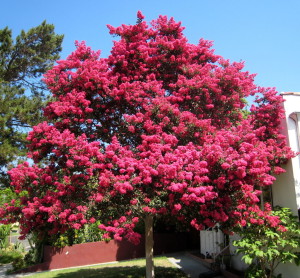
.
